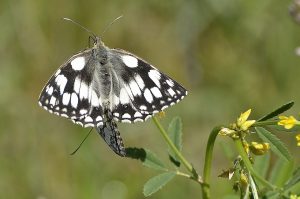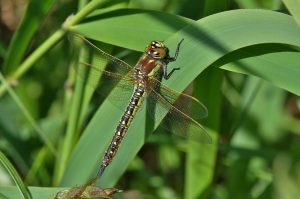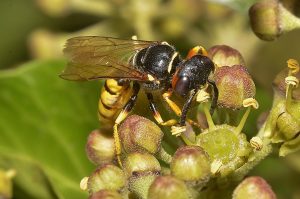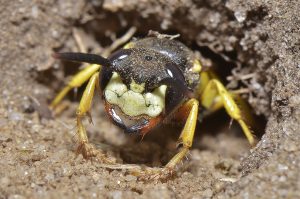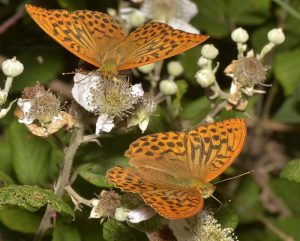
1 Silver-washed Fritillaries in the New Forest
Silver-washed Fritillaries (SWFs) are spectacularly wonderful butterflies: big, blowsy, gingery-orange with an intricate filigree upperwing and silvery underside. Watching one flying down a sunny woodland ride is a truly wondrous sight. So, it was with great interest that I read Gordon Dyne’s recent Facebook post (18/7/22) about SWFs at Wilwell. I saw my first SWF in Suffolk in 2012, and remember with great pleasure seeing it fly towards me, glowing ginger in the sun, before perching on a nearby tall thistle; I was so overwhelmed that I forgot to take a photo of it! I have since seen SWFs over the years in the New Forest but, perhaps my most memorable experiences came in August 2013, which strike a chord with the Wilwell sightings.
We live in Ruddington, not that far from Wilwell. On the morning of August 5th that year, looking out of the window, I saw an unfamiliar butterfly in the front garden. Grabbing my camera – kept ready, just in case! – I dashed outside to see, on the buddleia, what at the time seemed like an apparition, but was in fact a male Silver-washed Fritillary! I watched it for several minutes feeding first on the buddleia and then on Echinops flowers, before it flew off, leaving me to wonder if I was dreaming (although the images I captured told me I wasn’t).
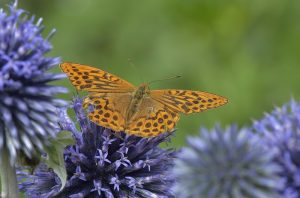
2 Feeding on Echinops, Ruddington
Then, two days later, I went to Staunton Quarry near Newark ( a gem of a place, home to Grizzled Skippers and so much more) hoping to find butterflies to watch and photograph. And my luck was well and truly in. Walking through the entrance, the first butterfly was a lovely Large White and the second was – you’ve guessed it! – another Silver-washed Fritillary, this time feeding on Ragwort.
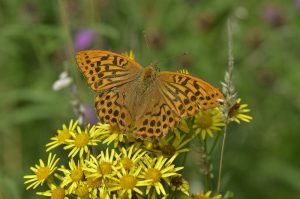
3 On Ragwort, Staunton Quarry
So, to misquote Oscar Wilde, whilst seeing one may have been fortunate, was seeing two in South Notts, in two days more than a coincidence? And was my astonished enthusiasm misplaced?
According to The Butterflies of Britain and Ireland (1) ’They were once found as far north as southern Scotland, but in recent years have been virtually unknown beyond a line between the River Mersey and the Wash’. The Eakring Birds website (2) shows only 9 records in the whole of the county for the years 1995 to 2012.
I recall contacting the County Recorder, who confirmed there had been a number of similar sightings in South Notts in 2013. Sadly, since then, I have not seen any more SWFs in my garden. However, almost regular annual visits to Cotgrave Forest over the past few years have produced a number of sightings, the last of these visits a fortnight ago producing at least a dozen sightings of SWFs in flight.
So, like Gordon, I wonder where they came from – natural range expansion northwards, possibly linked to climate change, or introduction?
The excellent Eakring Birds website(2) at one point seems to favour introduction, saying that ‘The Silver-washed Fritillary was released into Gamston and Eaton Woods near Retford a number of years ago, and where it still survives in small numbers. But recent years have seen an increasing number of records from across the county, which includes known releases of captive bred stock at both Dyscarr Wood and Cotgrave Forest in addition to Gamston and Eaton Woods, but probably also at several other sites.’
However, it follows this up by conceding the possibility of natural range expansion, saying ‘The number of isolated records from across the county suggests that the butterfly is making some natural attempt to recolonise Nottinghamshire. In July 2014, we found a dead Silver-washed Fritillary at the side of the A60 near Mansfield Woodhouse. Completely distanced from any suitable breeding habitat (or possible release site) the location suggests likely migration and so do other recent records from Newstead and Annesley CP, Annesley Pit Top, Staunton Quarry, Bestwood Lodge, Idle Valley NR, Rainworth and from gardens in Calverton, Cotgrave, Woodthorpe and Radcliffe-on-Trent.’
Neil Pinder, on his equally-excellent website (3) says ‘According to The Invertebrate Fauna of Nottinghamshire, 1916 by JW Carr, SWFs were formerly present quite widely in the first decade of the 20th century. Locations given are Rowhoe Wood (Widmerpool), Owthorpe and Bunny Woods, woods about West Leake and Gotham and Plumtree. The species was already in decline by then with the reduction of coppicing being blamed’. He goes on to say ‘In late July and August 2013 several sightings of this species were reported in Rushcliffe with at least 2 separate reports from Cotgrave village. They were present in good numbers in 2020 in Cotgrave Forest and now seem to be firmly established there’. Neil concludes ’the continuing presence of Silver-washed Fritillary (in Cotgrave Forest) since 2013 … suggests to me that recent introductions are the origin of these populations.’
So, perhaps it’s a case of paying your money and making your choice, Whatever the choice, the good news is that, on the face of it, we have a continuing SWF presence in Rushcliffe and we can only hope, as Gordon does, that ‘a local population is developing’ at Wilwell.
Chris Overton
July 2022
References
- The Butterflies of Britain and Ireland. Jeremy Thomas & Richard Lewington. British Wildlife Publishing. 2010.
- An historical review and modern atlas of Butterflies in Nottinghamshire. Eakring Birds. http://www.eakringbirds.com/butterfliesnottinghamshire.htm
- Rushcliffe Wildlife. The Wildlife and Wildlife Sites of Rushcliffe. https://www.rushcliffewildlife.co.uk/butterflies.html.
Images copyright Chris Overton

